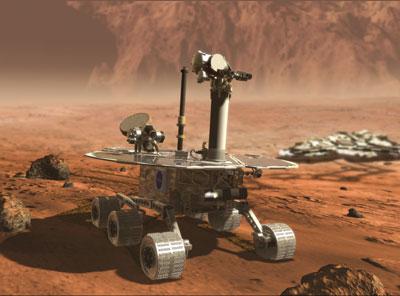Sat, Apr 12, 2003
Covering Twice The Ground
 If NASA has its way, not one, but two rovers will
soon be roaming the Red Planet, investigating areas that might have
once held bodies of water.
If NASA has its way, not one, but two rovers will
soon be roaming the Red Planet, investigating areas that might have
once held bodies of water.
NASA managers announced the two landing sites for the Mars
Exploration Rovers (MERs) Friday, saying both sites were
scientifically compelling. Four prospects were under consideration
and NASA made its final decision based not only on scientific
allure, but spacecraft technical concerns, said space science
program chief Ed Weiler.
"In choosing where to go, we need to balance science value with
engineering safety considerations," said Weiler. The first rover,
scheduled for launch on May 30, will be directed to Gusev Crater,
located 15 degrees south of Mars' equator (see map, bottom). The
second robotic scout, slated for liftoff on June 25, is targeted to
land at Meridiani Planum, which features rich deposits of gray
hematite, an iron oxide mineral associated with water. Meridiani
Planum is about 2 degrees south of the equator and halfway around
the planet from Gusev Crater.

Doing The Job Before The Lights Go Out
The first rover should reach its landing site on Jan. 4 and the
second on Jan. 25. Each is expected to last for about three months
before dust blankets the rovers' solar arrays, cutting off their
power. The rovers' masts will carry remote sensing instruments,
including high-resolution color cameras and infrared spectrometers
for studying the minerals in rocks and soil. The rovers also will
be equipped with a microscopic imager to see micron-size particles
and textures, an alpha-particle/x-ray spectrometer to determine
what elements the samples contain, and a Moessbauer spectrometer
for determining the mineralogy of iron-bearing rocks.

Each rover will carry a rock abrasion tool, similar to a
geologist's rock hammer, to remove weathered surfaces from rocks
and expose their interiors for analysis. The overall scientific
focus of the mission is to investigate what role water played on
Mars and to determine how suitable the conditions would have been
for life, said Cornell University's Steve Squyres, a principal
investigator.
More News
From 2023 (YouTube Versions): Flying Motorcycle, That Is… "First Flight was achieved under cloudy skies but calm winds. The Samson Sky team, positioned along the runway, wat>[...]
A Few Questions AND Answers To Help You Get MORE Out of ANN! 1) I forgot my password. How do I find it? 1) Easy... click here and give us your e-mail address--we'll send it to you >[...]
Discrete Code As used in the Air Traffic Control Radar Beacon System (ATCRBS), any one of the 4096 selectable Mode 3/A aircraft transponder codes except those ending in zero zero; >[...]
Beyond Visual Line Of Sight (BVLOS) The operation of a UAS beyond the visual capability of the flight crew members (i.e., remote pilot in command [RPIC], the person manipulating th>[...]
Aero Linx: Florida Antique Biplane Association "Biplanes.....outrageous fun since 1903." That quote really defines what the Florida Antique Biplane Association (FABA) is all about.>[...]
 Classic Aero-TV: The Switchblade Flying Car FLIES!
Classic Aero-TV: The Switchblade Flying Car FLIES! ANN FAQ: Q&A 101
ANN FAQ: Q&A 101 ANN's Daily Aero-Term (04.12.24): Discrete Code
ANN's Daily Aero-Term (04.12.24): Discrete Code ANN's Daily Aero-Term (04.13.24): Beyond Visual Line Of Sight (BVLOS)
ANN's Daily Aero-Term (04.13.24): Beyond Visual Line Of Sight (BVLOS) ANN's Daily Aero-Linx (04.13.24)
ANN's Daily Aero-Linx (04.13.24)





